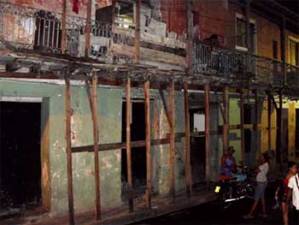Facades and Dangers
Dariela Aquique

HAVANA TIMES, April 30 — Busy and centrally located Heredia Street in Santiago de Cuba contains much of our history – especially that which relates to culture, since still located there is the house of Jose Maria Heredia, the writer of the classic song “Niagara.”
This artery extends for roughly twelve blocks. However, only three of them (between Calvary and San Pedro are very active – for several reasons.
First, this is because they are embedded in the city’s so-called “historic district,” whose buildings evidence a variety of architectural styles dating back to various periods but that have been preserved over time.

These have undergone restoration after restoration, sometimes by the occupants of dwellings, who are required to maintain the character of these structures.
On certain occasions (usually as a result of a visit by some important dignitary or due to some special event), restoration work is ordered of the Office of the Curator of the City, which is responsible for maintaining the patrimonial values of these structures.
On this street we can find significant and very popular sites (especially for tourists), such as La Casona de Artex, the Carnival Museum, the provincial headquarters of UNEAC and its art gallery (La Confronta), the birthplace-museum of Herida, the “Casa de la Trova” and numerous tables full of crafts on sale by local artisans.
No less important, but without enjoying such an influx of foreigners, but also on this street is the monumental Elvira Cape Provincial Library.

Adding to the avenue’s attractions is a small gallery of photos, books and records called the “La Galeria de Eddy,” as well as the cozy “El Holandes” restaurant. These two private businesses currently enjoy popularity and must be mentioned when talking about this street.
The sad thing about our walk down this street is when we stop and look at the housing stock — assets that are currently in deplorable condition — which contrast to the other buildings in a kind of light-dark contraposition.
The second floor of the building on Heredia and San Felix street has been propped up for than six years, though people always say that it’s full scale renovation is imminent. Otherwise it is likely that it will likely collapse at any time, given the unfortunate occurrences that happen on this well-known street.
Apathy, or what would be the imprudent closing of a facility that generates a significant cash flow in foreign currency, have caused not only the houses on Heredia to be exposed to dangerous degrees of deterioration.

A poster, barely visible, hangs from the balcony of the “Grand Hall” on the second floor of the Casa de la Trova, where almost every day of the week this space is crowded with tourists and visitors who are there to enjoy the music of groups of traditional artists or any other guest performers.
There, people drink and dance as the music reverberates through the flimsy beams that hold up the colonial-style balcony. Almost no one notices the small poster alerting disaster. It reads “Danger of Collapse.”
So, on this street where the poet Jose Maria Heredia was born, an avenue that is famous for its cultural nights back in the 1980’s, the route of bards and dilettantes, the witness of gatherings on the stairs, a street crowded with people walking up and down, you can see its painted facades and — running against the grain— a vacant lot, where years ago a building caught fire and was never rebuilt. Wood supports keep fragile floors falling in pieces and a small sign warns of danger.





